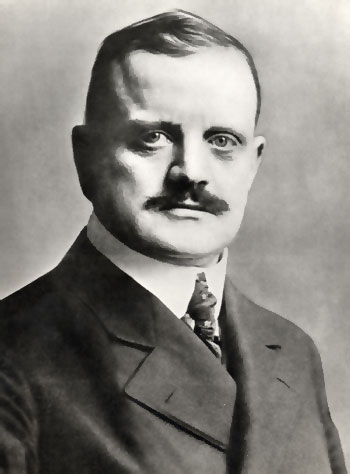
The throat operation marked the beginning of the "happiest years in Aino Sibelius's life. Now sober, Sibelius stayed more at home and composed introspective masterpieces. There was still stress caused by a fear of death, by a burden of debt and by ill health, but otherwise family life flourished.
"She [Aino] was sometimes playful with Daddy," their daughter Katarina Ilves said later. "They did all sorts of things when they were together. For example they might suddenly start to dance a waltz without music in what is now the dining room." Family happiness was increased by the birth of a fifth daughter, Margareta.
Sibelius had, for a change, promised to teach two talented composers, Toivo Kuula and Leevi Madetoja. Both of them later became renowned Finnish composers. There were long intervals between the lessons and towards the end of the year 1908 Sibelius could concentrate on writing Night Ride and Sunrise. At the end of November he sent the work to St Petersburg, to the conductor Alexander Siloti. Siloti conducted the first public performance at the beginning of 1909, but the reviews were crushing. The newspaper Novoye Vremya was bored by the work, asking: "Who is actually riding, and why?"
Sibelius continued listening to his inner voices. He was preparing a new string quartet, the first and only of its kind since his student years. He continued working in London in February 1909. Rosa Newmarch was delighted with Sibelius's new, sober condition.
In London, Sibelius conducted En Saga and Finlandia brilliantly, receiving high praise. He also visited Cheltenham, where Valse triste and Spring Song were played. There too the works were successful.
In London Sibelius also met Claude Debussy, who paid him compliments. The only setback of the tour came at a private recital at the Music Club. There, the composer Arnold Bax and others found Sibelius's short occasional pieces too limited in scope.
Sibelius began to keep a diary during his visit to London. At first he wrote down all his bills of exchange, which amounted to 55,000 marks (170,000 euros today). He did not include long-term loans, which would add a further 100,000 euros in today’s money.
Breitkopf & Härtel now wished to take Sibelius back into their stable. Oskar von Hase travelled to London to negotiate with the composer. Sibelius was already dissatisfied with the contract with Lienau, in which his yearly remuneration – in itself quite generous – was in principle granted only after the composer had delivered four major works during the year. Sibelius now signed a new contract with von Hase.
From London Sibelius moved to Paris, but just as before, he was unable to establish good musical contacts with the French capital. The journey continued to Berlin, where a doctor ascertained that his throat had healed. Feeling greatly relieved, Sibelius handed over the Voces Intimae quartet to Lienau. "It turned out as something wonderful. The kind of thing that brings a smile to your lips at the hour of death. I will say no more," Sibelius wrote self-confidently to Aino.
In Berlin he conceived an idea for a new work. An eight-bar sketch quickly scribbled at the Bar Riche contains the embryo of Luonnotar (Daughter of Nature). Sibelius left the idea to mature in his subconscious and prepared the songs, Opus 57, which finally set him free from the contract with Lienau. In Berlin, John Munsterhjelm immortalised him in a bust, which is today on display in Ainola.
See art in the drawing room at Ainola.
Towards the end of the 1909, Sibelius composed a number of pieces, including the ten piano pieces for Opus 58. A larger work began to take shape during an autumn journey to Koli, known as the "Finnish mountain", near Joensuu. Sibelius admired the landscapes with his brother-in-law, the painter Eero Järnefelt. He regarded the visit to Koli as one of the greatest experiences of his life.
Sibelius turned increasingly to the world of his own inner creativity. "I was no longer feeling at home in the town. The solitude of my life is beginning," he wrote in his diary on 10th January 1910. He put the finishing touches to In Memoriam, which he had been turning over in his mind for a long time.
His compositions were now travelling round the world on his behalf. In February 1910 Felix Weingartner conducted the second symphony in Vienna. The critic Julius Korngold wrote that the work had become "a very interesting acquaintance" and that the composer handled "his national material with brilliant technique".
Voces Intimae was performed for the first time at a concert of the Helsinki Music Institute on the 25th April. "The composition attracted a great deal of attention, and it is undoubtedly one of the most brilliant products in its field. It is not a composition for the public at large, it is so eccentric and out of the ordinary," was the verdict in Helsingin Sanomat.
In the spring, Sibelius quickly got started on his fourth symphony, but his financial situation made it necessary to write small pieces as well. "One has to combine things great and small. Symphonies and songs," he wrote in his diary on the 16th May. Personal bankruptcy had already been avoided several times only by the generosity of patrons whom Axel Carpelan had prodded into giving financial aid.
In October, Sibelius visited Kristiania, now Oslo, to conduct his works. He thought the concert was a success, even if the programme was demanding: Night Ride and Sunrise, a suite from the music of Swanwhite, The Dryad, In Memoriam and, after an interval, the second symphony, which was a guaranteed success. The short, almost impressionistic Dryad and the dramatic In Memoriam received their first public performances.
The audience went into raptures; Valse triste was played as an encore. In Tidens Tegn the critic "A. A." was full of admiration for the composer's original imagination and the mastery of the second symphony, writing, "In modern music one seldom hears anything as brilliant and as rich in ideas as the last movement." Verdens Gang praised the second symphony, but thought that the first symphony was thematically more significant. According to Örebladet's Ulrik Mörk, the composer only heaved large orchestral masses vaguely back and forth without being able to focus. But the verdict of Aftonposten's Otto Winter-Hjelm was the most devastating of all. He wrote: "[In Memoriam] loses a great deal because there is too much playing to the gallery, and to my mind Symphony 2 does not feel symphonic for the same reason."
Sibelius travelled from Kristiania to Berlin. He completed The Origin of Fire, he continued to work on the third movement of the fourth symphony and he met several composers and friends. "Everything feels so revoltingly petty. Still, Järvenpää [his home town] is the best of places, despite the darkness and the cold," Sibelius wrote.
At the beginning of November Sibelius was again in Järvenpää composing the finale of the fourth symphony. He had earlier agreed to a European tour together with the singer Aino Ackté, but his work on the fourth symphony now seemed more important. He cancelled the tour, much to the dismay of Ackté. He also broke his promise to Ackté to compose a song with orchestra based on Edgar Allan Poe's "The Raven", but themes from the sketches for the song were incorporated in the fourth symphony.
The year 1911 began with the finishing touches to the symphony. It was interrupted by a tour to Gothenburg and Riga. This was the first time he conducted his works in Sweden himself. The concerts in Gothenburg were tremendously successful, and even the third symphony was received by the critics with deep understanding.
In April, Sibelius's fourth symphony was completed. It confused the orchestral musicians with its new, introspective style, and with harmonies which utilised the augmented fourth (or tritone). In the rehearsals he asked Hugo Aure whether he understood the symphony. "Not quite," was the reply of this honest musician and copyist. "Then how would the audience understand it," Sibelius wondered.
At the concert, Sibelius conducted the work resolutely. Nevertheless, the audience was as perplexed as had been expected, even if shouts of bravo were heard when garlands were presented. While Sibelius was leaving the hall, the Choir of the Students’ Union sang Pacius's Song of Finland in his honour, and the critic and choirmaster Heikki Klemetti delivered a speech of thanks. Aino Sibelius was not taken in by this. "Evasive glances, shakes of the head, embarrassed or ironic smiles. Not many came to the dressing room to deliver their congratulations," she recollected later.
Sibelius conducted the fourth symphony again. The concert was a sell-out. The audience applauded wildly after the concert. It wanted to show that Sibelius was loved, even if the originality of the piece was not understood.
The critics were confused. Karl Fredrik Wasenius (under the pseudonym Bis) tried to make the work more understandable by telling his readers that the music described a journey to Koli. This Sibelius denied indignantly. Evert Katila from Uusi Suometar was contemptuous of Bis's view. He admired the work and saw the symphony as a declaration of war "against that superficiality, admiration of outward devices, empty effects of grandiloquence and supremacy of materialism, which is swallowing up modern music". The composer reacted calmly to the contradictory reception of the work. "Concert went well," he wrote. He told himself that great composers had always been misunderstood during their lifetime. "What right do I have to demand a different destiny from other great talents before me?" he asked.
In the summer of 1911 Ainola was being renovated. Another daughter, Heidi, was born on the 20th June, and the upper floor became habitable in September. In the upstairs study, Sibelius worked up a suite from the music composed in honour of the Finnish Press in 1899. The suite was called Scènes historiques. The movements All' overtura, Scena and Festivo were completed on 24th September 1911.
One month later Sibelius left for Berlin, and on the spur of the moment continued to Paris. "So you're in Paris. Fine, as long as you enjoy yourself. You are you, and you will not change," Aino commented.
The pieces Sibelius heard in Paris included Richard Strauss's Salome, whose instrumentation he considered masterly. Sibelius met many artists and friends in the city, but his music was still receiving few performances in France.
Sibelius returned home for his birthday, and his diary began to be filled with gloomy observations: "Do not get married, if you cannot offer your bride what she is used to. The same servants, the same food, the same clothes, the same – in a word – income." The lamentation was unjust, and Aino Sibelius later added her own note on the page: "My vigorous protest."
Sibelius's gloomy notes were typical for the darkest period of the year. He suffered from winter depression and was often at his gloomiest before his birthday on the 8th December. Christmas usually cheered the composer up, and he was on his best working form in the early spring.
At the beginning of 1912, Sibelius put the finishing touches to the new version of The Lover for strings and timpani, composed Song of the People of Uusimaa and did further work on the suite that was to become Scènes historiques II .
He was also considering an interesting offer: The Vienna Music Academy offered him a professorship in composition, since Robert Fuchs was about to retire. A safe source of income was necessary, but in March he decided to turn down the offer to make sure he would have enough time for composing.
He was already planning two new symphonies, the fifth and the sixth. Initially, he called the sixth symphony Luonnotar (Daughter of Nature) in his diary.
However, his major work in the spring of 1912 was the completion of three fairly short orchestral compositions. Sibelius named them Scènes historiques II. They were completed just before the first public performance on the 29th March.
The concert was a complete success. Referring to the fourth symphony, the critic Otto Kotilainen now thought he understood better "the strangely problematic impact it made on its first performance, at the concert a year ago". Scènes historiques II made Kotilainen excited. Writing in Helsingin Sanomat he claimed that the work was related to the fourth symphony and he praised "the wonderful richness of colour and the ingenuity of the thematic work". The concert ended with Livslust from ten years back, for female choir and orchestra.
The concert was repeated twice, but people were still fighting for tickets. After the fourth symphony was played at a concert in the community hall, Kajanus presented Sibelius with a laurel wreath bearing the words "Thank you for twenty years." This was, of course, a reference to the first public performance of Kullervo.
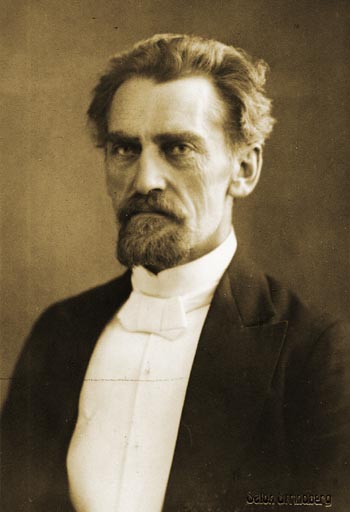
Robert Kajanus
In the summer of 1912 Sibelius was finishing three of his piano sonatinas. In September he travelled again to Britain at the invitation of Granville Bantock. On the 1st October, at the Birmingham Music Festival, Sibelius conducted his fourth symphony, which charmed the experts in the audience. The Times noted that Sibelius was a considerably more significant composer of modern music than Finlandia and En Saga had led people to believe.
The international performances continued in November in Copenhagen. For his concert, he chose the fourth symphony, Scènes historiques II and Night Ride and Sunrise. The critics noted that Sibelius's hands were shaking. He was already handicapped by nervousness and trembling hands, and the symptoms became worse with age.
At the start of 1913, when the fourth symphony was being performed around the world, he suffered something worse. In December 1912, the Vienna Philharmonic had refused to play the work despite the urgings of the conductor, Felix Weingartner. In a letter to Sibelius, Wilhem Stenhammar, Chief Conductor of the Gothenburg Orchestra, described how in a performance at Gothenburg in February, "loud expressions of indignation stifled a few cautious attempts at applause."
In March, the fourth symphony was performed for the first time in the United States. Walter Damrosch conducted the work in New York and warned the audience in advance about the unusual nature of the composition. A section of the audience left the hall between the movements. However, the magazine Musical America commented that the music was "unadulterated, formidably individual and formidably authentic". On the other hand, W. M. Humiston writing in the same magazine on the 9th August was of the opinion that Sibelius's music sounded "like the peculiar efforts of a badly trained or uneducated amateur composer".
In Boston, as late as October, the music met with bewilderment after a concert conducted by Carl Muck. "A muddle of the most wretched dissonances. It exceeds the saddest and sourest moments of Debussy," the Boston Journal wrote. "His fourth symphony is a sad failure," the Boston American commented sharply. The Boston Record was no more complimentary: "The approach is from the 20th or perhaps the 21st century […] The dissonant, melancholy murmurings led nowhere."
Such criticism was not exceptional from the perspective of the year 1913. Richard Strauss's Electra was said to remind the listener of "the squeaking of rusty hinges", "the screaming of babies" and "the whimpering of rats". At the end of the decade, Claude Debussy's music was described as "ugly", "passionless" and "impotent". The Finnish composer was in good company, in the front rank of musical innovators.
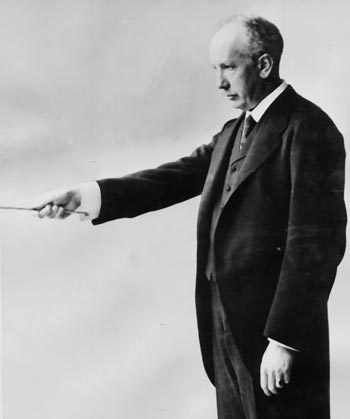
Richard Strauss
Sibelius spent the year 1913 in Finland. The musical output included the refined and reserved The Bard, which had its first public performance on 27th March 1913 in Helsinki. The reviews were respectful, and the fourth symphony, too, "called forth a storm of applause with shouts of bravo".
One reason for joy during the summer was the wedding of Sibelius's eldest daughter Eva to their neighbour Arvi Paloheimo, at Ainola on the 10th June. Sibelius seemed to be in good working form: during the summer he composed one of his great masterpieces, Luonnotar (Daughter of Nature) for soprano and orchestra. Aino Ackté performed the work for the first time at the Gloucester Music Festival on the 10th September. The Times praised the composer for his wonderfully rich imagination and for having a clearly individual compositional line. However, the fact that the text was in Finnish and that the score remained unpublished for a long time hindered the work from becoming established in concert programmes.
As usual, Sibelius’s diary notes became gloomier as the days grew shorter. "My mind is sick, not least because I have broken off relations with all my friends. Why. The fault surely lies with me," he wrote on the last day of the year.
Yet 1913 had been a great year. Works such as the pantomime music Scaramouche, composed for The Royal Danish Theatre, and several other smaller works, bore witness to his creative power.
At the beginning of 1914, Sibelius left to spend well over a month in Berlin, to compose and to hear new music. On the home front all was well: "All our marriage and our love just increases and grows greater and greater," his wife wrote.
Sibelius listened to a wide range of music in Berlin. He felt that Paul Juon's violin concerto and Weissman's piano concerto had been influenced by his own music. He was more interested in Debussy, Mahler, Strauss, the young Korngold and Arnold Schönberg. Sibelius loudly applauded Schönberg's chamber symphony when a section of the audience was booing.
"It is possible to see things this way. But it is a torment to the ears," he wrote in his diary. During the spring and the summer he often mentioned his interest in Schönberg to Aino and to interviewers, and he praised the composer.
As a result of a commission by the millionaire Carl Stoeckel, Sibelius composed a new orchestral work for the Norfolk Music Festival in the United States. In his first sketches, The Oceanides had three movements. The extant movements II and III were performed for the first time in Lahti, Finland, in the autumn of 2002. The next version was a one-movement version in D flat major. Sibelius sent this to the Norfolk Music Festival in the spring. But when the composer decided to travel to conduct the first public performance himself, he worked on it further to make it more coherent and he changed the key to D major. The D flat major version remained with Carl Stoeckel, who deposited it with Yale University. It was not performed until the autumn of 2002. However, the final D major version brought success to Sibelius, and during his trip he enjoyed both Stoeckel's luxurious hospitality and the high standard of the Festival Orchestra, which consisted of the best orchestral musicians on the east coast of America.
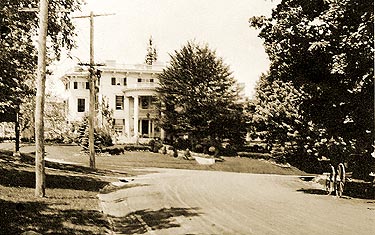
Carl Stoeckel, in whose residence Sibelius stayed when he visited America
The concerts displayed Sibelius's conducting at its best. Favourite pieces such as The Oceanides, Finlandia and Valse triste charmed the audience.
Henry Krehbiel, one of the great critics of the United States, confirmed the uniqueness of Sibelius’s American triumph. In his opinion The Oceanides was one of the most beautiful examples of sea music ever composed. He wrote that Sibelius was a genius of world class, as impressive on the conductor's rostrum as Richard Strauss or Arturo Toscanini.
The New York Times, too, regarded Sibelius's performance as the most notable event of the Norfolk Music Festival. The magazine The American ventured to claim that Sibelius had been the most fascinating and popular performer of all time at Norfolk.
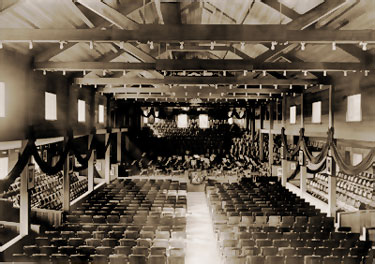
The Shed, the concert hall at Norfolk
With The Oceanides, Sibelius changed the minds of the American critics after the crushing reviews of the fourth symphony. A great number of critics, conductors and other influential figures in the musical life of the United States got to know Sibelius and his music at Norfolk. Their enthusiasm was evident during the following decades, when Sibelius became the most popular living composer in the United States.
The Stoeckels were hosts to Sibelius long after the concerts. They took him to the Niagara Falls and to Yale University, where he was given an honorary doctorate. By chance Sibelius was also given an honorary doctorate at the University of Helsinki during his time in the United States. Aino represented him in the ceremony at home.
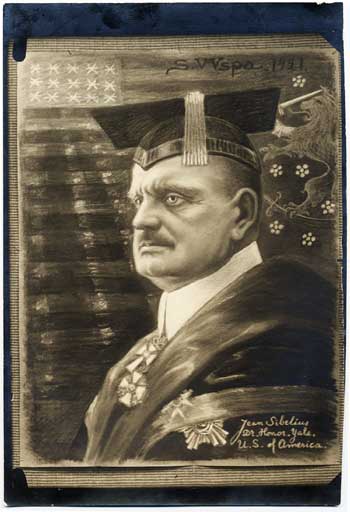
Sibelius in the robes of an honorary doctor of Yale University
Sibelius was now planning a profitable tour in the United States, perhaps for the following year. He wrote to his brother that his debt problems were about to be solved.
But events took another turn. On his voyage home, Sibelius heard about the shots fired in Sarajevo, and when he finally arrived home, the First World War was about to begin. It became more difficult to keep in contact with his German publisher when Germany and Russia drifted into war. Even if Finland was autonomous, it was still part of Russia and thus an enemy of Germany. Contact with his German publisher was lost, and even the journey to the United States had to be abandoned.
After the throat operation, Sibelius had been listening to his inner voices. At the very time when his style was becoming more harmonically accessible, and when he was regaining his sociable nature, the war was closing the world off from him.



